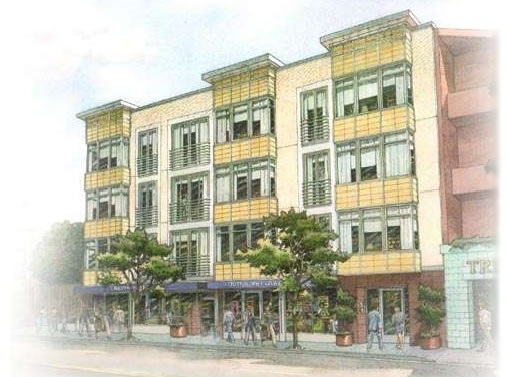
A full rundown of pricing for the 21 units that comprise The Bay (329 Bay Street):
∙ Listing: 329 Bay Street #101 (3/2) 1742 sqft – $1,195,000
∙ Listing: 329 Bay Street #102 (2/2) 1456 sqft – $979,000
∙ Listing: 329 Bay Street #202 (1/1) 659 sqft – $545,000
∙ Listing: 329 Bay Street #203 (2/2) 958 sqft – $785,000
∙ Listing: 329 Bay Street #204 (2/2) 958 sqft – $785,000
∙ Listing: 329 Bay Street #205 (1/1) 659 sqft – $545,000
∙ Listing: 329 Bay Street #206 (2/2) 1014 sqft – $799,000
∙ Listing: 329 Bay Street #207 (2/2) 869 sqft – $258,215 (BMR)
∙ Listing: 329 Bay Street #301 (2/2) 1009 sqft – $849,000
∙ Listing: 329 Bay Street #302 (1/1) 659 sqft – $224,199 (BMR)
∙ Listing: 329 Bay Street #303 (2/2) 958 sqft – $799,000
∙ Listing: 329 Bay Street #304 (2/2) 958 sqft – $799,000
∙ Listing: 329 Bay Street #305 (1/1) 659 sqft – $565,000
∙ Listing: 329 Bay Street #306 (2/2) 1014 sqft – $849,000
∙ Listing: 329 Bay Street #307 (2/2) 1225 sqft – $899,000
∙ Listing: 329 Bay Street #401 (2/2) 1014 sqft – $865,000
∙ Listing: 329 Bay Street #402 (1/1) 659 sqft – $579,000
∙ Listing: 329 Bay Street #403 (2/2) 958 sqft – $825,000
∙ Listing: 329 Bay Street #404 (2/2) 958 sqft – $839,000
∙ Listing: 329 Bay Street #405 (1/1) 659 sqft – $579,000
∙ Listing: 329 Bay Street #406 (2/2) 1014 sqft – $865,000
Monthly HOA dues are running $414 to $614 per month, and mid-March is the target for showings. (Oh, and a tip of the hat to the sales team for actually identifying the two BMR units rather than simply marketing them as “SOLD.”)
∙ The Bay Condominiums (329 Bay) [SocketSite]

Wait a minute, I was just by there, it’s not all foggy like that at the edges of the building! Prejury, fraud, liquidated damages, alimony.
So, how does one go about getting a BMR unit?
Earn as little as you can, get on a list and keep your earnings tiny as you work your way up the list over a period of ten to twelve years. The value of your unit is controlled and there’s a deed restriction that forces you to sell at a very small profit to the next qualified buyer. So do you really own it?
Here is the BMR information from the San Francisco Mayor’s Office of Housing for eligibility:
http://www.sfgov.org/site/moh_page.asp?id=48083
Normally, the sales center will have a preferred lender who will also handle the BMR lottery.
There was an interesting article on BMRs in Carol Lloyd’s “Surreal Estate” column in the Chronicle last month. I was surprised to learn about the resale restrictions.
The link posted by Wayne is very informative. You do not get the full benefits of ownership but still are responsible for paying the same homeowners fees and special assessments. What in the world is the advantage of this program besides a failed attempt at Social Engineering? It is not ownership, but more like renting in owner occupied buildings. If you cannot take advantage of the rise in value of your unit, do you really own it when the city will be setting the cost you will be able to sell it for someday? Build more housing and that will reduce costs. I am curious if someday there will be a premium on resales in buildings that do not have BMR units? (This is the case in Santa Monica)
From a Socketsite article last November:
“And while Ameen addresses interest payments versus affordability, we can’t help but wonder if a similarly structured program wouldn’t make more sense, and be more efficient, than the city’s current “Below Market Rate” (BMR) program.”
https://socketsite.com/archives/2006/11/a_better_model_than_bmr.html
Or instead of BMR housing, let’s get affordable housing for all.
Did a 2/2 just sell for $334,000?
There was an interesting article on BMRs in Carol Lloyd’s “Surreal Estate” column in the Chronicle
Great Article. Note how Ms. Hernandez’ first reaction to increasing homeowner fees is to turn to the city to pay for it. When that fails, she looks to sue. Apparently, she is surprised that no one will take up her case.
When she discovers the price of her unit has fallen, she again goes to the city to make sure that she won’t lose her downpayment. Amazing.
Then, there is this quote:
“Why would anyone ever buy a house if they could lose their down payment?” When I explained that in a declining market, for an ordinary home buyer — not one supported by a government program — it was indeed possible, she seemed surprised.
But Hernandez is not the only one confused. Look at these nuggets from the reporter:
“Inclusionary housing has been touted as one of the few benefits accorded to the have-nots to emerge from the decadelong development boom….
Even if new housing in San Francisco was increasingly tailored to the very wealthy, inclusionary-housing laws made sure that at least some of the profits developers were reaping would go to the people who could otherwise never have afforded a home in the city….
By all accounts, inclusionary-housing programs have been successful…. there have been 550 inclusionary-housing units built..”
Never is there any mention of the cost of BMR, or the role it plays in increasing prices, thereby contributing to pricing people out. All the money comes from “developer’s profits”. Nowhere is there is a discussion that by making units more expensive to develop, the developers are incentivized to sell higher-end units. The focus on higher end units is interpreted as some bizarre God-given fact, completely unrelated to the costs of doing business in this city.
Moreover, the success or failure of the program is only determined by whether the law is actually obeyed, not by the effects of the law on the market, nor on people such as Ms. Hernandez, who have no business buying real estate.